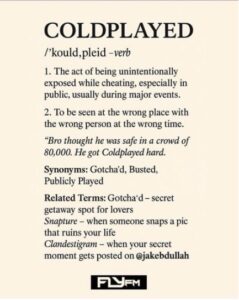Pop culture has served up some doozies lately, for those in the business of crisis communications.
But while the popcorn emoji was used to full effect for 2025’s most prolific case – Coldplaygate – it’s worth taking a moment to break down the elements of how this PR disaster got out of control on a global scale, before taking an incredible turn.
What made Coldplaygate a full-blown reputational crisis
We all know the story: A viral moment on the Jumbotron Kiss Cam at a Coldplay concert in Toronto turned into a global scandal when the couple caught on camera were revealed to be executives from the American SaaS company Astronomer. Within hours, memes and reels flooded social media. Within days, both execs had resigned. And within a week, Astronomer’s brand recognition had skyrocketed – for all the wrong reasons.
But what made this a reputational crisis wasn’t just the scandal – it was the speed, scale, and saturation of the narrative. Analysis from risk intelligence platform Resolver showed over 365,000 mentions from 214,000 unique users in just two weeks. The company’s web traffic surged 15,000%, not from curiosity, but from scrutiny.
How social media shaped the crisis
The virality wasn’t driven by mainstream media – it was Reddit threads, Discord screenshots, and decentralised platforms like BlueSky. These are the blind spots in most crisis playbooks. Brands often miss early signals because they’re not named directly. By the time Astronomer caught up, the narrative was already out of their hands.
Traditional media was even fooled as the story began to take hold – early reports suggested that then-Astronomer CEO Andy Byron had issued an apology statement, even quoting Coldplay lyrics. It was eventually confirmed that that statement was a fake (the spoof X account name was Peter Enis…go figure). Meanwhile, the memes kept piling in.


The stages of crisis comms: Astronomer’s response
- Detection & Pause
Astronomer didn’t rush. They paused, assessed, and aligned internally. This gave them control over tone and timing. - Acknowledgment & Action
Leadership changes were announced swiftly. The company acknowledged the incident without sensationalising it. - Narrative Reframing
Enter Ryan Reynolds’ agency, Maximum Effort. A satirical video featuring Gwyneth Paltrow as a spokesperson flipped the script. It was absurd, self-aware, and brilliant – turning scandal into strategy. - Reconnection
By leaning into cultural irony, Astronomer reconnected with audiences. The campaign became a case study in emotional intelligence and brand agility.
American Eagle: When controversy converts
The American Eagle x Sydney Sweeney campaign was meant to be cheeky. The slogan – “Sydney Sweeney has great jeans” – was a play on words. But critics saw something darker: eugenics, white supremacy, and a tone-deaf nod to genetic privilege. The backlash was swift, amplified by celebrities like Lizzo and Doja Cat.
Then came Trump.
On X (formerly Twitter), he declared it “the hottest ad out there”. Sales surged. Website traffic spiked. And spending among Republicans overtook Democrats for the first time since the campaign launched.
Crisis comms, or culture war?
American Eagle didn’t respond with satire or strategy. They stayed quiet. The brand clarified the slogan’s intent but didn’t engage further. Instead, they let the market speak.
This wasn’t a recovery – it was a realignment. The campaign became a symbol of tribal marketing, where political identity drives consumer behaviour more than product quality.
What these cases teach us
- Speed matters – but so does silence
Astronomer paused strategically. American Eagle stayed quiet. Both approaches worked – for different reasons. - Narrative control is everything
Whether through satire or restraint, shaping the story is key. - Culture is the new currency
In 2025, brand perception is shaped by memes, influencers, and political endorsements.
Marketing 101 is back
American Eagle made $200 million in one day. It wasn’t the ad – it was the alignment. The rediscovery of basic marketing principles – know your audience, speak their language, and let them feel seen – was the real win.
If you’d like to find out more about communicating in a crisis, or storytelling that drives your narrative, contact us for a no-obligation chat.
